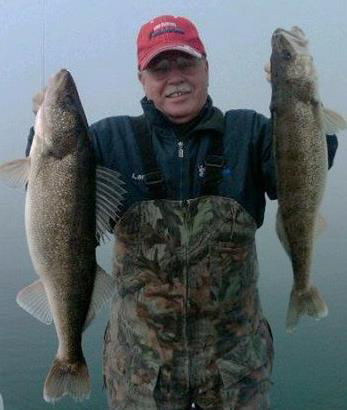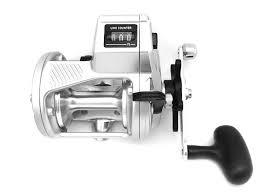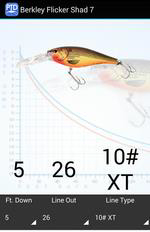Calibrating Line Counters: The first step to successful trolling

Some of the biggest fish caught every year in lakes big and small are caught trolling. In the Great Lakes region where I live and guide, most walleye are caught trolling, especially the giant open water fish that prowl Lakes Erie, Huron and Michigan. Successful trolling takes a lot of work. Finding fish, getting lures to the right depth, dialing in the right speed, picking the right lure size, shape, action and color and staying on active fish are all parts of the trolling puzzle. Paying attention to details on the water leads to better fishing, but I am convinced that trolling success is determined by some things you do BEFORE you hit the water too.
Let's take a few minutes to talk about line counter reel calibration and why it is such an important part of successful open water trolling. First, we want to be able to get our lures to an EXACT depth. The Precision Trolling app gives us the information of how much line we need to get a specific lure to an exact depth. Second, we want to be able to duplicate a presentation that is working in our boat on other rods, and have reels that are calibrated is essential to this. Third, we may want to give or get information from our fishing buddies about what is working. If the reels on both boats are calibrated the same, sharing info is easy and more important, accurate. 60' back on your reels should be the same amount of line out as 60' on your buddies reel. If everyone calibrates, it will be. Fourth, the Precision Trolling app was created with a calibrated reel, so if you use the app and want precise depth control, you need to be calibrated.
I have talked with anglers who use the "Write it down" method of knowing how much line is out; that is they pull out line until the counter on the reel says 100, then they measure how much line is actually out and write it somewhere on the reel. Every reel is different and there is NO way to be accurate.
So why doesn't the "Write it down" method work? The big issue is that line counters do not count actual feet. The counter moves one digit (we call it a foot) every time the spool rotates a certain distance, which moves the line pickup along the worm gear a specified distance. What changes is how much line goes out or comes in every time the line pickup moves the specified distance and changes the number on the counter 1 digit. The true, measured amount of line taken up or let off the spool every time the counter changes 1 digit is DIRECTLY RELATED TO THE DIAMETER OF THE SPOOL! So if our counter reads different than 100 when we let out an actual measured 100 feet of line we need to CHANGE THE DIAMETER OF THE SPOOL by adding or subtracting line.

For example, we measure 100' on the ground, walk to one end, attach our line to a clip, zero our line counter, open the spool and let line out as we walk to the other end of the measured 100'. When we get there the counter on the reel reads 104. We are NOT simply off 4' or need to adjust the amount of line on the spool by 4'. We need to CHANGE THE DIAMETER OF THE SPOOL! In this case, since our counter is reading more than 100 at 100 measured feet, we actually need to ADD line to the spool and increase the diameter. But not just 4'. In our experience it takes from 8-15 linear feet of line to change the counter 1 foot! So in this case, to change the counter 4' and be accurate we actually need to add about 32-60 measured feet of line to get the counter to read 100 with 100 measured feet of line out.
I spend lots of time at the marina helping guys with this. I will come in with some fish and they had been running the same bait, same distance back in the same place with lesser results. The first thing I do is have them go get their line counter reels and I go get my stakes! (I carry a set of plastic tent stakes in the boat with 100' of nylon line between them). We will then measure the line on their reels and without fail one or more of the following occurs:
1) They have NEVER heard of calibrating a reel
2) They have a mixed bag of reels, reel sizes, line diameters, line types and amounts of line on their reels
3) NONE of the reels match each other (so they can't even duplicate in their own boat…I call this the "one rod caught all the fish" syndrome)
4) None of the reels have 100' of line out when measured against 100 on the counter

Comparing their reels to mine is where things get interesting. Let' say I was catching fish with 60' of line out. I pull out 60 on the counter and I have out very close to 60' of measured line out. Now they pull out line until their counter reads 60, and the fun begins! Some of their reels will only have 35-40 feet of measured line out (their lures are shallower than mine-no good) or 65-75 measured feet of line out (their lures are deeper than minedefinitely not good).
I love the A-HA moments from guys when we show them how it works, and I have yet to talk with someone we have taught this to who stops doing it. Usually the first thing they do is help their fishing buddies so they know they are talking the same language on both boats.
Is being accurate to the foot with your lure depth that important? If you are fishing certain places at certain times of the year than maybe not. But in my experience of trolling for walleye all over the country, in all types of conditions, the answer is YES! Check some of the dive curves on the Precision Trolling app (available for download at www.precisiontrollingdata.com) and see the depth difference that extra 5-10 feet of line out makes. I have witnessed days where letting a lure back 50' caught fish and the same lure back 45 or 55' caught nothing! I wouldn't think of trolling with uncalibrated reels.
Now that we are calibrated and catching fish, what if something happens on the water and we lose some line from the reel causing it to be out of calibration? We have a couple of options:
1) the easiest way is to have extra reels in the boat ready to go, but that is not always possible
2) carry extra line on the boat and respool and recalibrate on the boat
3) remove the same amount of line from the other reels in the boat so at least we can duplicate in our boat for the rest of the trip or
4) fish the way it is and hope
If extra reels are not available, then option 2 is your best choice. Now the obvious question is how much line do I put on? I can't measure 100' of line on the boat to get the diameter right, so how do I get calibrated again? Simple solution. When you are calibrating your reels on land add another step before you go fishing. Follow the calibration steps and get the spool diameter right so the counter is reading 100 with a measured 100' of line out. Now use and empty reel (it does not need to have a counter) and use it to remove 300-400 feet of line off of the calibrated reel (use the counter on the calibrated reel). Cut the line from the calibrated spool. Now we have 400' on the extra reel. Tie and overhand knot in the line coming from the calibrated spool, creating a loop. Attach the line from the extra reel to the loop with any know you use (I like the uni knot) and reel the line onto the calibrated reel. Now if you need to respool on the boat, simply go back to the loop, tie on new line, zero the counter and add 300-400' (whatever you chose when you removed line on land) and you are VERY CLOSE to being calibrated!

Below is something I like to do after I have my reels calibrated:
1) Add a 6mm bead onto the line
2) Attach a crankbait snap to the line
3) Tie a leader of 16-20lb fluorocarbon line about 36-48" long with a high quality ball bearing swivel at one end and a crankbait snap at the other
4) Attach the swivel of the leader to the snap on the calibrated line
Now most of the issues of frayed line, twisted line, tangles etc. are on the LEADER and not my calibrated line. I re-tie the knot attaching the crankbait snap to my calibrated line every 2-3 trips and most years never lose any line from the reel. Not only does this setup (shown below) help in the ways listed above, but it makes it VERY EASY to switch fishing methods and depth control devices…another topic for another day